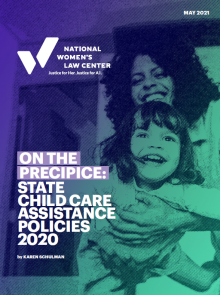Abortion rights, women of color, and LGBTQI+ people are under attack. Pledge to join us in fighting for gender justice.
 Child care is crucial for the well-being of parents, children, and our nation. It enables parents to work and support their families, or obtain education or training to get a better, more stable job. It gives children a safe, nurturing environment to learn and develop skills they need to succeed in school and in life. By bolstering the current and future workforce, it serves as the backbone of our nation’s economy. The importance of child care has become clearer than ever during the COVID crisis. Yet, the pandemic has also illustrated—and exacerbated—the fragility of our child care system.
Child care is crucial for the well-being of parents, children, and our nation. It enables parents to work and support their families, or obtain education or training to get a better, more stable job. It gives children a safe, nurturing environment to learn and develop skills they need to succeed in school and in life. By bolstering the current and future workforce, it serves as the backbone of our nation’s economy. The importance of child care has become clearer than ever during the COVID crisis. Yet, the pandemic has also illustrated—and exacerbated—the fragility of our child care system.
Many families, particularly low-income families, struggle with the high price of child care. At the same time, child care workers—who are predominantly women and disproportionately women of color—are paid poverty-level wages, and Black and Latina child care workers typically earn even less than their white peers. Solving this dilemma—in a way that relieves the burdens on both families and child care workers—requires significant additional public investment.
The Child Care and Development Block Grant (CCDBG), the major federal child care assistance program, provides some support for families needing child care and for child care programs and providers. However, due to inadequate funding, there are significant gaps in child care assistance policies, which are set by states within federal parameters. To assess the status of state child care assistance policies—where the gaps are, where progress is being made, and where further progress is needed—this report examines states’ policies in five key areas, including:
- Income eligibility limits to qualify for child care assistance;
- Waiting lists for child care assistance;
- Copayments required of parents receiving child care assistance;
- Payment rates for child care providers serving families receiving child care assistance; and
- Eligibility for child care assistance for parents searching for a job.
This state-by-state analysis of policies as of February 2020—just prior to the beginning of the pandemic shutdown—demonstrates that our child care assistance system entered the crisis with profound weaknesses. In many states, low income eligibility limits left numerous low- and moderate-income families unable to qualify for child care assistance, long waiting lists prevented eligible families from receiving assistance, high copayments placed a cost burden on families able to receive assistance, and low payment rates deprived child care programs of the resources needed to fairly compensate child care workers and to support high-quality care.
The gaps in child care assistance policies stem from insufficient funding for child care. While temporary relief funding for child care approved in December 2020 and March 2021 will help programs to survive the COVID crisis, it is also necessary to make a long-term investment in addressing these gaps that pre-dated the crisis and in building a stronger child care system.

